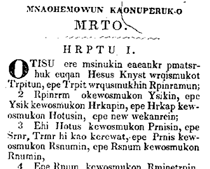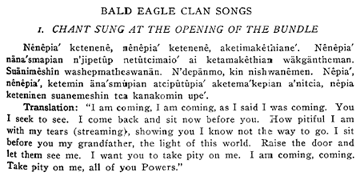![]()
![]() Potawatomi Orthography
Footnotes
Potawatomi Orthography
Footnotes
|
Potawatomi dictionary
bode'wadmimo speak Potawatomi nIshnabe'k The People mzenegenek books |
Orthography - rationale
Home page: news & updates nizhokmake'wen resources/help BWAKA - about us |
Here are a few examples of written Potawatomi. We will be adding more as we have time. Notice how different they are from each other, and consider what it would take to learn any of these systems.
Not that ours is so much better than any of these attempts. We actually borrow many ideas from several of these sources. We simply have tried to assess our contemporary audience, and then choose symbols that we think will be most/easiest used by them.

This example is from the first page of a biblical text, The Gospel According to Matthew and the Acts of the Apostles, translated by Johnston Lykins, published in 1844. It was printed for the purpose of evangelizing Potawatomis in the 19th century.
If you click on the image at right, you will go to our hypertext edition of
Lykins' translation in his original orthography, which includes a brief
orthographic key. The link is to chapter 1 of the Gospel According to Matthew.
We have 7 chapters of the Gospel in the original orthography on line. We also
have the complete translation, converted to BWAKA orthography, on the website.
If your browser does not support frames, here are links to:
Lykins' original orthography
Chapter 1 of the Gospel According to
Matthew in Lykins' orthography, with an English translation
Here's another example of written Potawatomi: Alanson Skinner, "The Mascoutens, Or Prairie Potawatomi," Bulletin of the Public Museum of the City of Milwaukee, 1924. Skinner, an ethnologist, wrote for an academic and linguistic, rather than Potawatomi, audience.

Of the 4000 enrolled Prairie Band Potawatomi members, about 500 live on the reservation near Mayetta, Kansas. Many are spread throughout the nation, often in urban centers.
Only a few of the People (on and off the rez) speak the language. We are assuming that those young and old folks that will want to learn the language, are first speakers of the English language, so a familiar Roman alphabet will be already known or at least intuitive when it wanders from the norm. We hope.
Some of our symbols are different from English, since there are some Potawatomi sounds not often used in English and because we have chosen to make our vowels somewhat less ambiguous and interpretative.
We use symbols that are available or left-over from the English set to stand for
unusual sounds. These are really the only new symbols a student of Potawatomi
will need to learn. They include:
e' pat jIshe' (uncle)
I fit nijItso (how much?)
v buck mvkcako (frog)
c chair cmokman (non-Indian)
It's worth mentioning again that our other vowels (a, e, i, etc.) signify only
one sound each.
We do not think it is that important how the symbols are marked (this has been a matter of great debate, but we are tired of that). The important thing is that any marked e (e'), i (i' OR I), or u (u' OR v) signifies a different sound. When writing by hand, I use a dot or dash over these vowels; same with s (s' = sh) and z. You might say that our c (ch sound) is marked.
Bottom line: the symbols above are what we came up with, mainly to keep things as simple and intuitive (consider our English speaking learners) as possible AND to make writing on line as easy as possible (that's why we gave up on dotting the s and z...).
Like dad says, now is that thick as mud?
One last thing: A main reason for going to all this trouble is to distinguish
between vowels. In particular, there is a sound never used in English, except
for imitative words like ga-ga (baby talk) and ba-a-a-a (sheep talk). That's our
marked e', which comes often at the end of Potawatomi words (example: kwe' [woman]). Because it goes against English nature, new speakers invariably
attempt to prounounce e' as e or a, or even ey.
[woman]). Because it goes against English nature, new speakers invariably
attempt to prounounce e' as e or a, or even ey.
|
Potawatomi dictionary
bode'wadmimo speak Potawatomi nIshnabe'k The People mzenegenek books |
Orthography - rationale
Home page: news & updates nizhokmake'wen resources/help BWAKA - about us |